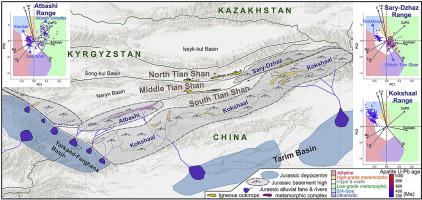Geoscience Frontiers ( IF 8.9 ) Pub Date : 2020-07-16 , DOI: 10.1016/j.gsf.2020.06.003 Stijn Glorie , Samantha March , Angus Nixon , Fun Meeuws , Gary J. O’Sullivan , David M. Chew , Christopher L. Kirkland , Dmitry Konopelko , Johan De Grave

|
This paper presents an apatite U–Pb and geochemistry archive for exposed plutons and metamorphic rocks of the Kyrgyz South Tian Shan (STS) within the Central Asian Orogenic Belt. Apatite U–Pb dates and trace-element geochemistry are provided for 17 samples from late Carboniferous – early Permian I-type granites in the Terktinsky complex and A-type granites in the Kokshaal Range; early Devonian granites in the Kembel complex; Cryogenian granitoids and tuffs from the Middle Tian Shan and gneisses from the Atbashi metamorphic complex. These samples form a comprehensive selection of igneous and metamorphic rocks within the cores of Mesozoic basement highs that supplied detritus to adjacent basins such as the Tarim, Ferghana and Yarkand-Ferghana Basins. Generally, the granitoid samples preserve primary igneous apatite U–Pb ages that are within uncertainty of previously published zircon U–Pb dates. The apatites from the Atbashi metamorphic complex record anomalous Ordovician dates with large uncertainties that are interpreted as mixing ages between Cryogenian protolith formation and Carboniferous metamorphism. Principal component analysis discriminates apatite samples from the different bedrock terranes in the Kyrgyz STS based on their geochemical fingerprint and categorizes the samples with respect to an extensive apatite geochemical archive. The combined apatite-zircon archive provides a novel framework for provenance studies on the Meso–Cenozoic sedimentary history of the Central Asian Orogenic Belt.
中文翻译:

吉尔吉斯斯坦南天山(中亚)的磷灰石U-Pb定年和地球化学:建立磷灰石指纹图谱用于物源研究
本文介绍了中亚造山带内吉尔吉斯南天山(STS)裸露的岩体和变质岩的磷灰石U-Pb和地球化学档案。从Terktinsky岩体中的石炭纪晚期至二叠纪早期I型花岗岩和Kokshaal范围内的A型花岗岩中的17个样品提供了磷灰石的U-Pb年代和微量元素地球化学。Kembel复合体中的早期泥盆纪花岗岩;来自天山中部的低温花岗岩和凝灰岩,以及来自Atbashi变质复合体的片麻岩。这些样品形成了中生代地下高位岩心内火成岩和变质岩的综合选择,这些碎屑向邻近的盆地(如塔里木盆地,费尔干纳盆地和雅尔肯-费加纳盆地)提供了碎屑。通常,花岗岩样品保留的原生火成磷灰石U–Pb年龄在先前公布的锆石U–Pb日期的不确定性范围内。来自Atbashi变质复合体的磷灰石记录了异常的奥陶纪年期,具有很大的不确定性,这被解释为低温原岩形成与石炭纪变质之间的混合年龄。主成分分析基于吉尔吉斯斯坦STS不同基岩地层的地球化学特征来区分磷灰石样品,并根据广泛的磷灰石地球化学档案库对样品进行分类。磷灰石-锆石组合档案为中亚造山带中新生代沉积史的物源研究提供了一个新颖的框架。来自Atbashi变质复合体的磷灰石记录了异常的奥陶纪年期,具有很大的不确定性,这被解释为低温原岩形成与石炭纪变质之间的混合年龄。主成分分析根据吉尔吉斯斯坦STS不同基岩地层的地球化学特征来区分磷灰石样品,并根据广泛的磷灰石地球化学档案库对样品进行分类。磷灰石-锆石组合档案为中亚造山带中新生代沉积史的物源研究提供了一个新颖的框架。来自Atbashi变质复合体的磷灰石记录了异常的奥陶纪年期,具有很大的不确定性,这被解释为低温原岩形成与石炭纪变质之间的混合年龄。主成分分析根据吉尔吉斯斯坦STS不同基岩地层的地球化学特征来区分磷灰石样品,并根据广泛的磷灰石地球化学档案库对样品进行分类。磷灰石-锆石组合档案为中亚造山带中新生代沉积史的物源研究提供了一个新颖的框架。主成分分析根据吉尔吉斯斯坦STS不同基岩地层的地球化学特征来区分磷灰石样品,并根据广泛的磷灰石地球化学档案库对样品进行分类。磷灰石-锆石组合档案为中亚造山带中新生代沉积史的物源研究提供了一个新颖的框架。主成分分析根据吉尔吉斯斯坦STS不同基岩地层的地球化学特征来区分磷灰石样品,并根据广泛的磷灰石地球化学档案库对样品进行分类。磷灰石-锆石组合档案为中亚造山带中新生代沉积史的物源研究提供了一个新颖的框架。



























 京公网安备 11010802027423号
京公网安备 11010802027423号